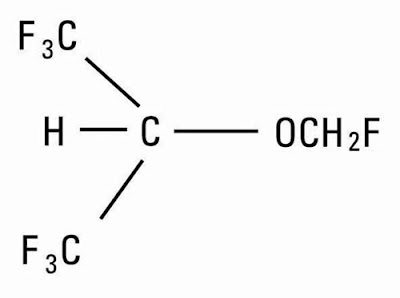Sevoflurane: An Ideal Inhalation Anaesthetic for Surgeries
 |
| Sevoflurane |
Sevoflurane is a widely used
inhalation anesthetic for general anesthesia. It has certain properties that
make it an ideal choice for carrying out surgical procedures smoothly.
Physical and Chemical Properties
Sevoflurane is a haloether that is clear, colorless, and nonflammable liquid at
room temperature. Its chemical formula is C4H3F7O and molecular weight is 200.
Its boiling point is 58°C which allows it to vaporize quickly from the
vaporizer into the carrier gas. Some key physical properties that make it
suitable for anesthesia include low solubility in blood and tissues,
nonpungency, and negligible metabolism. These ensure a rapid onset and offset
of anesthesia.
Rapid Onset and Offset of Action
Due to its low solubility, Sevoflurane
produces anesthesia very quickly after inspiration. This property allows fast
induction of anesthesia as the patient loses consciousness within 2-3 minutes
of starting sevoflurane inhalation. Similarly, when administration is
discontinued, sevoflurane is rapidly eliminated from the body through
expiration. Patients regain consciousness quickly within 5-10 minutes,Resume
pre-anesthesia level of consciousness. This rapid offset of action makes
sevoflurane ideal for short outpatient surgeries as it allows speedy recovery
and discharge.
Hemodynamic Stability
During induction and maintenance of anesthesia, sevoflurane does not cause
significant changes in heart rate and blood pressure as compared to other
gases. This hemodynamic stability is beneficial for patients with
cardiovascular diseases. The stable cardiovascular function also makes
sevoflurane suitable for surgeries involving minimal blood loss like
laparoscopic procedures.
Minimal Respiratory Depression
Sevoflurane exerts less depressing effect on respiration compared to older
halogenated gases. It produces minimal reductions in tidal volume, respiratory
rate, and minute volume especially at 1-2 MAC concentrations required for
surgery. This characteristic reduces the need for mechanical ventilation in
minor procedures.
Nausea and Vomiting
Postoperative nausea and vomiting (PONV) is an unpleasant complication of
anesthesia. Sevoflurane, when used as the sole anesthetic, is associated with a
low incidence of PONV. This favorable side effect profile and early recovery
enhances patient satisfaction in the postoperative period.
Advantages over Other Agents
In this section, we will compare sevoflurane with other commonly used
inhalation anesthetics to highlight its advantages:
Comparison with Isoflurane
Both isoflurane and sevoflurane are highly volatile ethers used for
inhalation-based general anesthesia. However, sevoflurane has a lower blood-gas
partition coefficient than isoflurane which allows faster induction and
emergence. Additionally, sevoflurane provides more hemodynamic stability and
fewer reports of exciting emergence phenomena like involuntary muscle
movements.
Comparison with Desflurane
Desflurane is another low-solubility gas used for rapid-sequence inductions.
Though desflurane has a faster emergence than sevoflurane, its high volatility
increases operating room expenditures due to increased gas consumption.
Sevoflurane consumption is lower making it more cost-effective compared to
desflurane, especially for prolonged procedures.
Comparison with Nitrous Oxide
Nitrous oxide (N2O) is used as an adjunct to other inhalational agents, but its
sole use as anesthetic has been limited. Sevoflurane does not require N2O for
favorable anesthetic profiles, making it safer for procedures like
abdominal/neurosurgeries where N2O is best avoided. It also obviates the need
for N2O scavenging systems.


Comments
Post a Comment